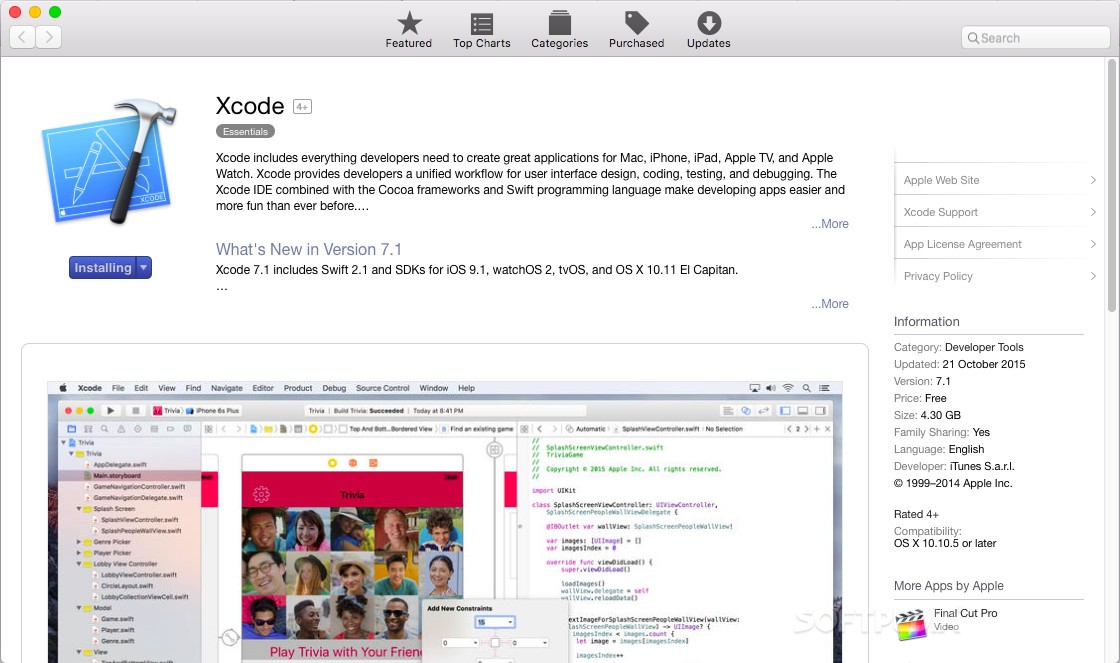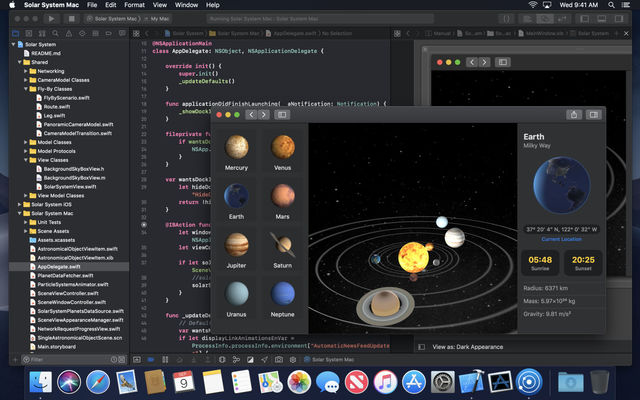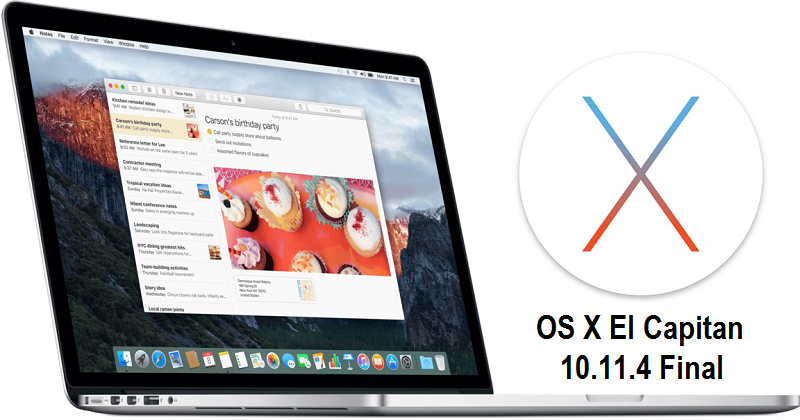Supported platforms
Xcode For Mac 10.11.6 Xcode is Apple's integrated development environment (IDE) for macOS, used to develop software for macOS, iOS, iPadOS, watchOS, and tvOS.It was first released in 2003; the latest stable release is version 12.4, released on January 26, 2021, and is available via the Mac App Store free of charge for macOS Big Sur users. 1.9 : Xcode 8 dropped 10.11 SDK, get it from Xcode 7.3.1 2.0 : Xcode 8 cannot always link i386 for OS X 10.5, use the Xcode 3 linker for this arch too. Force use of legacy assembler with GCC 4.x. MacBook Air, OS X El Capitan (10.11.6), Xcode Posted on Nov 26, 2018 9:57 AM Reply I have this question too (881) I have this question too Me too (881) Me too. The last Xcode version compatible with El Capitan is Xcode 8.2.1. If you can't install it from within Apple App Store, visit Apple Developer and download the app there. An Apple ID is required. Xcode is provided as xip file (signed zip). You can simply unzip it by using Archives.app (i.e. With a double-click). If using Xcode 4.3.1 or later for Mac OS X 10.7, 10.8, 10.9, 10.10 or 10.11, or macOS 10.12 or 10.13, you must open Xcode (under 'Applications') and additionally select to install 'Command Line Tools' in 'Preferences'.
- 10.6 (Snow Leopard)
- 10.7 (Lion)
- 10.8 (Mountain Lion)
- 10.9 (Mavericks)
- 10.10 (Yosemite)
- 10.11 (El Capitan)
Prerequisites
To develop applications using the GStreamer SDK for OS X you will needOS X Snow Leopard (10.6) or later andXCode 3.2.6 orlater.

The recommended system is macOS Sierra withXCode 8
Download and install the SDK
There are 3 sets of files in the SDK:
- The runtime files are needed to run GStreamer applications. Youprobably want to distribute these files with your application (orthe installer below).
- The development files are additional files you need to createGStreamer applications.
- Mac OS X packages that you can usewith PackageMakerto deploy GStreamer with your application
Get both the runtime and the development installers from here.
On Mac OS X 10.6 (Snow Leopard) you have to install Python 2.7 manually. It is included in later versions of OS X already. You can get it from here.
The downloads areInstaller Packages(.pkg).
Double click the package file and follow the instructions presented bythe install wizard. In case the system complains about the package notbeing signed, you can control-click it and open to start theinstallation. When you do this, it will warn you, but there is an optionto install anyway. Otherwise you can go to System Preferences → Securityand Privacy → General and select the option to allow installation ofpackages from 'anywhere'.
These are some paths of the GStreamer framework that you might finduseful:
- /Library/Frameworks/GStreamer.framework/: Framework's root path
- /Library/Frameworks/GStreamer.framework/Versions: path with all theversions of the framework
- /Library/Frameworks/GStreamer.framework/Versions/Current: link tothe current version of the framework
- /Library/Frameworks/GStreamer.framework/Headers: path with thedevelopment headers
- /Library/Frameworks/GStreamer.framework/Commands: link to thecommands provided by the framework, such as gst-inspect-1.0 orgst-launch-1.0
For more information on OS X Frameworks anatomy, you can consult thefollowing link
Configure your development environment
Building the tutorials
The tutorials code, along with project files and a solution file forthem all, are in thegst-docs in theexamples/tutorials subdirectory.
To start building the tutorials, create a new folder in your Documentsdirectory and copy thefolder /Library/Frameworks/GStreamer.framework/Current/share/gst-sdk/tutorials.
You can fire up XCode and load the project file.
Press the Run button to build and run the first tutorial. You canswitch the tutorial to build selecting one of the available schemes.
Creating new projects
The GStreamer binaries provides aframeworkthat you can drag and drop to XCode to start using it, or using thelinker option -framework GStreamer*.*
There is a small exception to the regular use of frameworks, and youwill need to manually include the headers searchpath /Library/Frameworks/GStreamer.framework/Headers
- XCode: Add the headers path to Search Paths → Header SearchPaths
- GCC: Using the compileroption -I/Library/Frameworks/GStreamer.framework/Headers
GAMIT/GLOBK Prerequisites
A PDF version (68 kB) of this web page is available in A4 or letter paper format and in thedocumentation directory of the GAMIT/GLOBK FTP server.
This information is compiled through experience with first-time users ofGAMIT/GLOBK from workshops and elsewhere. Details are provided for installingGAMIT/GLOBK on Linux, Mac and Windows. Additional information is provided on optional programssuch as GMT (required forany GAMIT/GLOBK scripts that produce plots), Tom Herring's tsview and velview tools andCATS (see here also).

All GAMIT/GLOBK workshop participants must arrive having read through andcompleted the steps shown on this web page before the start of the workshop.
This is particularly important given the time and resource constraints whendownloading very large package files such as Xcode for Mac users, which willproduce unnecessary and unwanted delays.
GAMIT/GLOBK
Introductory and reference manuals
We provide a Quick Start Guide and anIntroduction to GAMIT/GLOBK as well as more detailedreference manuals for GAMIT and GLOBK. We recommend that all users using the softwareat least read the first two documents before starting with the software andrefer to the latter documents for more advanced information as you gainexperience.
In addition to a basic UNIX- or Linux-based operating system, there are fourfundamental requirements for installing GAMIT/GLOBK on any system:
- a Fortran compiler;
- a C compiler;
- X11 libraries and headers, specifically:
- an X11 library (libX11.a, libX11.so, libX11.dylib, libX11.la or libX11.dll.a); and
- an X11 header file (Xlib.h).
Many systems will have some or all of these installed by default but othersmay not. Below are some details about what to expect from various systems that Ihave experience with.
Once you have completed the steps described for your system, below, you maydownload and install GAMIT/GLOBK from the source code provided on the FTPserver. Further information is available on the main GAMIT/GLOBK web page.
Linux
There are many different types of Linux system and each is slightlydifferent. However, if you are a Linux user, it is likely that you are familiarwith the command line interface, the requirements described above and installingpackages as necessary. So I will restrict myself here simply to note a couple ofspecific points that I am aware of.
It is likely that most Linux systems will have a Fortran and C complilerinstalled by default. However, be sure to check with your system administratoror review instructions from your OS distributor (e.g. compilers on Ubuntu) to ensure that this is the case. You may also need toinstall the 'gcc-multilib' and/or 'gfortran-multilib' packages to ensurecompatibility.

Beware that some systems (e.g. Ubuntu) may also require installation of cshand tcsh for GAMIT/GLOBK scripts to run. These may be installed quickly andeasily through, e.g., the Ubuntu Software Center or
sudo apt install makelibx11-dev csh tcsh
Mac
Apple provides many advanced command line tools with Xcode, a package mostlydesigned for developers of software but which also contains a C compiler and theX11 libraries and headers required for GAMIT/GLOBK. One must be registered as an AppleDeveloper in order to log in and download Xcode or the Command Line Toolsonly but the program is free to join and there are no obligations. Note thatthis is different from the regular Apple ID.

Once registered, login, search for Xcode and download the latest version for your system (as ofthe last update of this web page):
- Xcode 11.1.3 or 'Command Line Tools for Xcode 11.1.3' for macOS 10.15 (Catalina);
- Xcode 10.3 or 'Command Line Tools (macOS 10.14) for Xcode 10.3' for macOS 10.14 (Mojave);
- Xcode 10.1 or 'Command Line Tools (macOS 10.13) for Xcode 10.1' for macOS 10.13 (High Sierra);
- Xcode 9.2 or 'Command Line Tools (macOS 10.12) for Xcode 9.2' for macOS 10.12 (Sierra);
- Xcode 8.2 or 'Command Line Tools (macOS 10.11) for Xcode 8.2' for Mac OS X 10.11 (El Capitan);
- Xcode 7.2 or 'Command Line Tools (OS X 10.10) for Xcode 7.2' for Mac OS X 10.10 (Yosemite);
- Xcode 6.2 or 'Command Line Tools (OS X 10.9) for Xcode - Xcode 6.2' for Mac OS X 10.9 (Mavericks);
- Xcode 5.1.1 or 'Command Line Tools (OS X Mountain Lion) for Xcode - April 2014' for Mac OS X 10.8 (Mountain Lion);
- Xcode 4.6.3 or 'Command Line Tools (OS X Lion) for Xcode - April 2013' for Mac OS X 10.7 (Lion);
- Xcode 3.2.6 for Mac OS X 10.6 (Snow Leopard);
- Xcode 3.1.4 for Mac OS X 10.5 (Leopard).
From February 2012 and Xcode 4.3, Command Line Tools areavailable as a separate, smaller download also, which significantly reduces thesize of the installation. Note that Xcode, but not the separate Command LineTools sub-package, is available through the App Store for Mac OS X 10.7.3(update of Lion) and later, or macOS.
If using Xcode 4.3.1 or later for Mac OS X 10.7, 10.8, 10.9, 10.10 or 10.11,or macOS 10.12 or 10.13, you must open Xcode (under 'Applications') andadditionally select to install 'Command Line Tools' in 'Preferences'.Alternatively, run
Xcode does not include a Fortran compiler but you can install one using theinformation provided here.
As of Xcode 4.4, Apple has also discontinued support of X11. XQuartz may instead be installed forthe required X Windows libraries and headers described above, which will beplaced in /opt/X11/lib and /opt/X11/include, respectively, rather than /usr.However, a link from /usr/X11 to /opt/X11 is created, so all Mac users may keepthe following set in libraries/Makefile.config:
X11LIBPATH /usr/X11/lib
X11INCPATH /usr/X11/include
Windows
Recent releases of Windows 10 have the ability to install and run a more'native' command line. Follow the Microsoft Docsinstallation guide to install the 'Windows Subsystem forLinux'. Once complete, ensure installation of required packages, e.g. forDebian-based distributions such as Ubuntu:
sudo apt installgfortran make libx11-dev csh tcsh bc
or for RPM-based distributions such as openSUSE:
sudo zypper installgcc-fortran libX11-devel tcsh ftp hostname
Otherwise I recommend installing a virtual machine (e.g. VirtualBox or VMWare Workstation Player),which then requires the installation of a regular Linux distribution (e.g. Ubuntu) to run via the virtualmachine. One may then install and run GAMIT/GLOBK on this virtual machineoperating system.
Previously I had preferred to use Cygwin,which is a common Linux 'emulator' for Windows, for installing and runningGAMIT/GLOBK. To install Cygwin, download and run setup-x86.exe (32-bit) or setup-x86_64.exe (64-bit) to begininstallation. Generally the defaults shown throughout the installation processare adequate and need not be changed. There are, however, specific packageswhich are required in addition to the default Cygwin packages that areinstalled. These are at least:
Download Xcode 8 For Mac
- Devel/gcc-fortran (allowing the required dependencies to be installed will ensure the GCC core packages are also installed, including a C compiler)
- Devel/make
- Math/bc
- Shells/tcsh
- X11/libX11-devel
One may search for the appropriate packages from the Cygwin package search. Search for'libX11.*' and 'Xlib.h' for the X11 libraries and header file, respectively, tofind the appropriate package.
I also highly recommend installing the X11/xinit package and itsdependencies. This will provide an X Windows environment from which one can openand use, for example, Emacs for creating or editing text files. This isimportant given then different end-of-line characters between Windows and othersystems (Unix, Linux and Mac OS X or macOS).
Download Xcode For Os X 10.11
Additional software
There are several additional programs that users may find useful, if notnecessary, to install. The major addition is GMT, which is required for anyGAMIT/GLOBK scripts that produce plots, e.g. sh_plot_pos, sh_plotvel, etc. GMTproduces Postscript graphics which are most readily viewed using, for example,'gs' or 'gv'.
You can install GMT for Debian-based Linux distributions such as Ubuntu fromthe main repository with a command such as:
sudo apt installgmt gmt-dcw gmt-gshhg
or for RPM-based distributions such as openSUSE from a community repository witha command such as:
sudo zypper ar -fhttp://download.opensuse.org/repositories/home:/beyerle:/IAC/openSUSE_Leap_15.1/home:beyerle:IAC.repo
or:
sudo zypper ar -fhttp://download.opensuse.org/repositories/home:/beyerle:/IAC/openSUSE_Leap_42.3/home:beyerle:IAC.repo
etc. depending on your distribution, then:
sudo zypper installGMT
Xcode 11.7 Download
Tom Herring has produced GUI-basedprograms for time series (tsview) and velocity (velview) viewing and simplemanipulation.